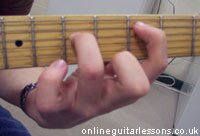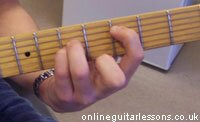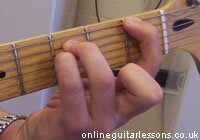|
Power chords are used by many artists because they are basically a chord which can be moved around almost anywhere on the fret board. Power chords are based on the root note and it's perfect fifth.
e|---------|
B|---------|
G|---------|
D|----5----|
A|----3----|
E|---------|
|
 |
In this example, the root note is C. In the scale of C, you have the notes C D E F G A B C. So now that you have the root note, you can find the perfect fith. The perfect fifth is the fifth note in the scale, so the perfect fifth of C is G (C D E F G A B C). So the power chord of C would consist of a C and a G. Sometimes the octave can be added. This makes the chord a little brighter. So you add another C an octave higher, so it would look like this...
e|---------|
B|---------|
G|----5----|
D|----5----|
A|----3----|
E|---------|
|
 |
So this is the power chord of C, however it is usually refered to as C5. So if you wanted the F5 chord, it would be the power chord of F. You would have the root note, F, the perfect fifth, C, and the octave, F.
e|---------|
B|---------|
G|---------|
D|----3----|
A|----3----|
E|----1----|
|
 |
So all you have done is keep the same postion, but you have moved the chord so that F is the root note.
Now that you have learnt a bit about power chords, just try and practise moving the power chord up and down the fret board like this...
e|-------------------------------------------------|
B|-------------------------------------------------|
G|-------------------------------------------------|
D|-3-3-3-5-5-5-7-7-7-5-5-5-3-3-3-5-5-5-9-9-9-7-7-7-|
A|-3-3-3-5-5-5-7-7-7-5-5-5-3-3-3-5-5-5-9-9-9-7-7-7-|
E|-1-1-1-3-3-3-5-5-5-3-3-3-1-1-1-3-3-3-7-7-7-5-5-5-|
That exercise was only played on one string, so try this exercise on two stings...
e|----------------------------------------------------|
B|----------------------------------------------------|
G|---------------------------6--6--6--6-6-4--4--4--4--|
D|--4--4--4--4-4-2--2--2--2--6--6--6--6-6-4--4--4--4--|
A|--4--4--4--4-4-2--2--2--2- 4--4--4--4-4-2--2--2--2--|
E|--2--2--2--2-2-0--0--0--0---------------------------|
|
|



